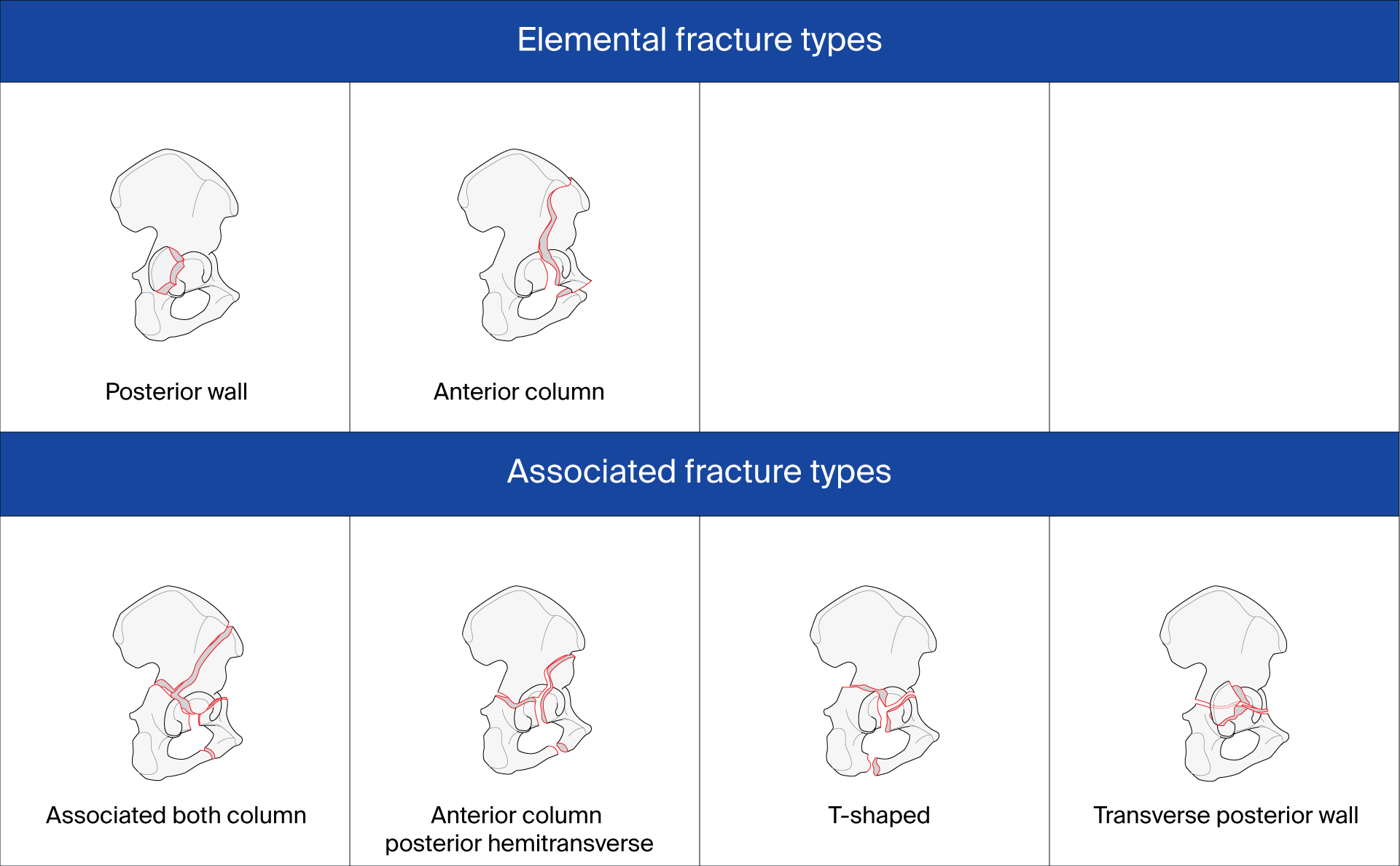Types of acetabular fractures and their indications
Preview
In the first part of this series, Rodrigo Pesantez from the Universidad de los Andes Medical School and Colegio Mayor de Nuestra Señora del Rosario, Bogotá, Colombia, explains the acetabular fracture patterns commonly seen in elderly patients, walks us through the definitions of and indications for acute and delayed total hip arthroplasty (THA) as a treatment for acetabular fractures, presents known (negative) prognostic factors, and looks at outcomes for both acute and delayed THA.

Rodrigo Pesantez
Universidad de los Andes Medical School and Colegio Mayor de Nuestra Señora del Rosario, Bogotá, Colombia
Acetabular fracture patterns in the elderly
Acetabular fractures in elderly patients are increasing, with the incidence in patients over 60 years of age being 24% of all acetabular fractures [1]. The failure rate of open reduction and internal fixation (ORIF) as a treatment for these fractures in this population is high, leading to delayed THA in around 17‑30.4% of patients [2]. Acetabular fractures according to Letournel [3] are classically divided into elementary and associated patterns, with elementary patterns including posterior wall, posterior column, anterior wall, anterior column, and transverse fracture patterns; the associated patterns include T-shaped, posterior wall and posterior column, transverse and posterior wall, anterior and hemitransverse, and fractures of both columns [3]. It has been shown that the fracture pattern occurring in the elderly is different to that occurring in the younger population [1]. Ferguson et al [1]—in their epidemiological and radiological study of acetabular fractures in patients over 60 years of age—revealed that fractures characterized by displacement of the anterior column are more common in the elderly (64%) than in younger patients (43%). Here, the common fracture patterns in the elementary group were anterior column (19.2%) and posterior wall (13.2%), and in the associated group were both column (26.4%), anterior column posterior hemitransverse (14.9%), T-shaped (10.2%) and transverse posterior wall (8.1%) (Figure 1) [1].
Definition of acute versus delayed total hip arthroplasty
Total hip arthroplasty as a treatment for acetabular fractures can be used in different settings. According to Pesantez, surgeons are faced with performing a THA in an acute or in a delayed setting. When an acute THA is performed, it is either used as an immediate intervention or it can be staged by up to 3 weeks [4]. “On the contrary,” as Pesantez notes, “a delayed THA can be performed in different instances. The perhaps most extreme scenario is when a patient presents with an untreated acetabular fracture. This can also be referred to as a neglected fracture, which is discussed in more detail in Part 3 of this series of articles. Otherwise, a delayed THA can be performed after failure of acetabular fracture management be it nonoperative or ORIF”. Pesantez adds, “in some cases, the original ORIF was perhaps poorly executed resulting in a bad outcome for the patient, whereas in other cases the ORIF was well executed, but due to the severity of the injury the patient has a bad outcome with the development of osteoarthritis.” The following two cases describe classical situations in which an acute THA is performed as the immediate treatment for an acetabular fracture (Case 1), and in which a delayed THA is performed because of failure of the nonoperative treatment (Case 2).
Read the full article with your AO login
- Acetabular fracture patterns in the elderly
- Acute vs delayed total hip arthroplasty definition
- THA indications
- (Negative) prognostic factors
- Treatment options & outcomes
- Conclusions
AO Recon resources
Contributing experts

Ashok S Gavaskar
Orthopedic Trauma and Arthroplasty Services, Rela Institute and Medical Centre, Chennai, India

Rodrigo Pesantez
Universidad de los Andes Medical School and Colegio Mayor de Nuestra Señora del Rosario, Bogotá, Colombia

Ramesh K Sen
Institute of Orthopedic Surgery,
Max Hospital, Mohali, India
This article was edited by Lyndsey Kostadinov, AO Innovation Translation Center, Clinical Science, Switzerland.
References
- Ferguson TA, Patel R, Bhandari M, Matta JM. Fractures of the acetabulum in patients aged 60 years and older: an epidemiological and radiological study. J Bone Joint Surg Br. 2010;92(2):250-257.
- Simko P, Braunsteiner T, Vajczikova S. [Early primary total hip arthroplasty for acetabular fractures in elderly patients]. Acta Chir Orthop Traumatol Cech. 2006;73(4):275-282.
- Letournel E. Acetabulum fractures: classification and management. Clin Orthop Relat Res. 1980(151):81-106.
- Liang K, Gani MH, Griffin X, Culpan P, Mukabeta T, Bates P. Acute versus delayed total hip arthroplasty after acetabular fracture fixation: a systematic review and meta-analysis. Eur J Orthop Surg Traumatol. 2023;33(7):2683-2693.
- Clarke-Jenssen J, Roise O, Storeggen SAO, Madsen JE. Long-term survival and risk factors for failure of the native hip joint after operatively treated displaced acetabular fractures. Bone Joint J. 2017;99-B(6):834-840.
- Tannast M, Najibi S, Matta JM. Two to twenty-year survivorship of the hip in 810 patients with operatively treated acetabular fractures. J Bone Joint Surg Am. 2012;94(17):1559-1567.
- Firoozabadi R, Hamilton B, Toogood P, Routt MC, Shearer D. Risk Factors for Conversion to Total Hip Arthroplasty After Acetabular Fractures Involving the Posterior Wall. J Orthop Trauma. 2018;32(12):607-611.
- Enocson A, Blomfeldt R. Acetabular fractures in the elderly treated with a primary Burch-Schneider reinforcement ring, autologous bone graft, and a total hip arthroplasty: a prospective study with a 4-year follow-up. J Orthop Trauma. 2014;28(6):330-337.
- Weaver MJ, Smith RM, Lhowe DW, Vrahas MS. Does Total Hip Arthroplasty Reduce the Risk of Secondary Surgery Following the Treatment of Displaced Acetabular Fractures in the Elderly Compared to Open Reduction Internal Fixation? A Pilot Study. J Orthop Trauma. 2018;32 Suppl 1:S40-s45.
- Nilssen P, McKelvey K, Lin C. Revision Surgery Risk After Open Reduction and Internal Fixation Versus Acute Total Hip Arthroplasty in Geriatric Acetabular Fractures: A Nationwide Study. J Am Acad Orthop Surg. 2024;32(11):e533-e541.
- MacCormick LM, Lin CA, Westberg JR, Schmidt AH, Templeman DC. Acute total hip arthroplasty versus open reduction internal fixation for posterior wall acetabular fractures in middle-aged patients. OTA Int. 2019;2(1):e014.
- Jauregui JJ, Weir TB, Chen JF, Johnson AJ, Sardesai NR, Maheshwari AV, Manson TT. Acute total hip arthroplasty for older patients with acetabular fractures: A meta-analysis. J Clin Orthop Trauma. 2020;11(6):976-982.
- Nicol GM, Sanders EB, Kim PR, Beaulé PE, Gofton WT, Grammatopoulos G. Outcomes of Total Hip Arthroplasty After Acetabular Open Reduction and Internal Fixation in the Elderly-Acute vs Delayed Total Hip Arthroplasty. J Arthroplasty. 2021;36(2):605-611.
- Borg T, Hernefalk B, Hailer NP. Acute total hip arthroplasty combined with internal fixation for displaced acetabular fractures in the elderly: a short-term comparison with internal fixation alone after a minimum of two years. Bone Joint J. 2019;101-b(4):478-483.
- Denyer S, Hoyt AK, Eikani C, Cohen J, Brown NM. Thirty-Day Outcomes After Acute Total Hip Arthroplasty Combined With Internal Fixation of Acetabular Fractures: A Multi-Institutional Database Analysis. J Am Acad Orthop Surg Glob Res Rev. 2023;7(12).
- Kahhaleh E, Belzile EL, Reed-Métayer T, Dartus J, Plante D, Lesieur M, et al. Combined Hip Procedure Versus Open Reduction and Internal Fixation for Displaced Acetabular Fractures in Patients Older than 75 years: A Matched Cohort Study. Journal of Orthopaedic Trauma. 2023;37(12):601-606.
- Lin C, Caron J, Schmidt AH, Torchia M, Templeman D. Functional outcomes after total hip arthroplasty for the acute management of acetabular fractures: 1- to 14-year follow-up. J Orthop Trauma. 2015;29(3):151-159.
- Manson TT, Slobogean GP, Nascone JW, Sciadini MF, LeBrun CT, Boulton CL, et al. Open reduction and internal fixation alone versus open reduction and internal fixation plus total hip arthroplasty for displaced acetabular fractures in patients older than 60 years: A prospective clinical trial. Injury. 2022;53(2):523-528.
- Smakaj A, Rovere G, Scoscina D, De Mauro D, Erasmo R, Battiato C, et al. Outcomes of acetabular fractures treated with acute fix and replace versus open reduction and internal fixation in elderly population: a multicentric retrospective study. Int Orthop. 2022;46(11):2659-2666.
- Tu TY, Chen CY, Lin PC, Hsu CY, Lin KC. Comparison of primary total hip arthroplasty with limited open reduction and internal fixation vs open reduction and internal fixation for geriatric acetabular fractures: a systematic review and meta-analysis. EFORT Open Rev. 2023;8(7):532-547.
- Scott CEH, MacDonald D, Moran M, White TO, Patton JT, Keating JF. Cemented total hip arthroplasty following acetabular fracture. Bone Joint J. 2017;99-b(10):1399-1408.
- Kirkeboe RL, Nordsletten L, Madsen JE, Dybvik E, Lie SA, Hallan G, Clarke-Jenssen J. Long-term follow-up and survival of delayed total hip arthroplasty following acetabular fracture: a matched cohort study of 552 cases from the Norwegian Arthroplasty Register. Hip Int. 2024;34(3):396-401.
- Morison Z, Moojen DJ, Nauth A, Hall J, McKee MD, Waddell JP, Schemitsch EH. Total Hip Arthroplasty After Acetabular Fracture Is Associated With Lower Survivorship and More Complications. Clin Orthop Relat Res. 2016;474(2):392-398.
- Shaker F, Esmaeili S, Nakhjiri MT, Azarboo A, Shafiei SH. The outcome of conversion total hip arthroplasty following acetabular fractures: a systematic review and meta-analysis of comparative studies. J Orthop Surg Res. 2024;19(1):83.





